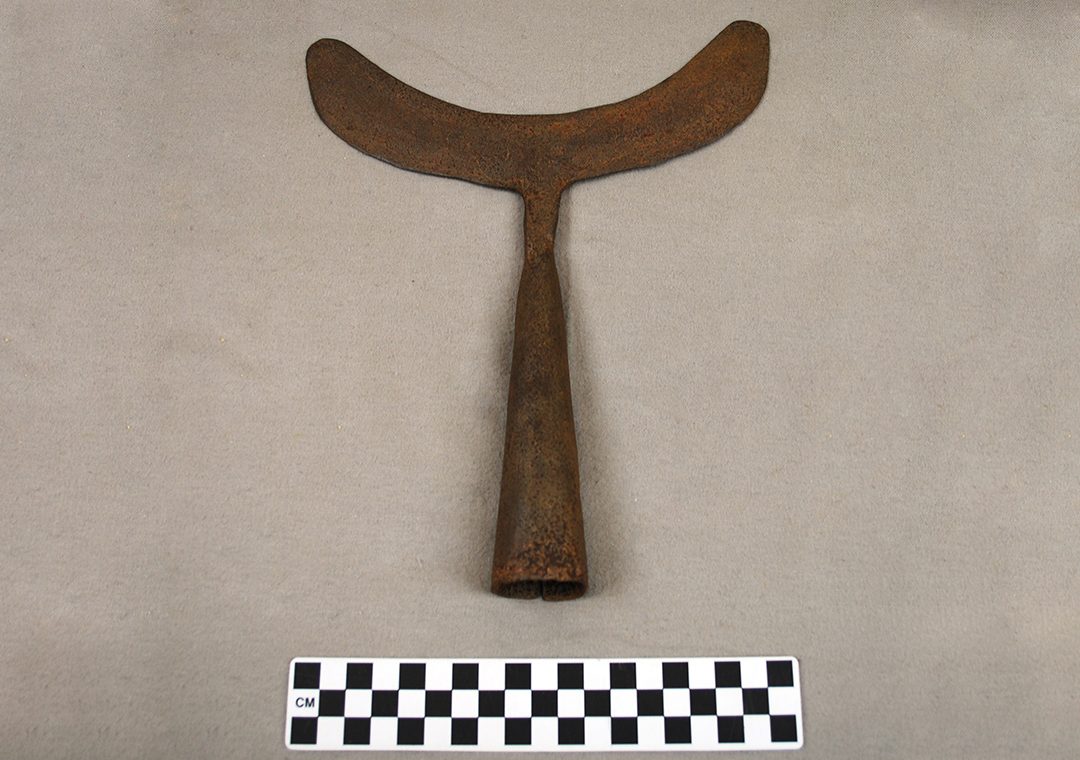This object is a reproduction of a hocking knife. Hocking knives are ranching tools that would have been used to cut the ligaments on a cow’s back legs making it impossible for the animal to run. This was only used on cattle that were going to be butchered. Hocking knives would have been attached to a pole about eight to ten feet long. As the rancher rode up on a horse behind his chosen cow he could easily stop the animal and return to for it later to take it to the next phase for slaughter and butchering. This is no longer practiced today as it is considered inhumane. It was replaced with the lariat or lasso, which is used to rope cattle.
The ranching and butchering of cattle, or cows, in Texas goes back to the time of the conquistadors. The word ranch comes from the Mexican-Spanish word rancho which meant a place involved with livestock, which included cows, goats, sheep, and horses. Once Hernan Cortes conquered the Aztecs, in what is now central Mexico, he and his men moved quickly to claim the surrounding area for the Spanish crown. The Spanish were used to a diet that included beef and Cortez soon established cattle herds which spread across Mexico.
Texas had been claimed but mostly ignored through the 1500s as the Spanish focused on their Central American investments which contained silver mines. However, French presence in Louisiana made the Spanish nervous. In 1685, a Frenchman named René Robert Cavelier, Sieur de La Salle had accidentally landed at Matagorda Bay on the east coast of Texas. By 1687 the Spanish had heard the news and sent out expeditions until they finally found the failed settlement, which had been wiped out by local East Texas Indians. Paranoid that the French would try and take Mexico and the valuable silver mines, the Spanish began to establish missions in Texas in order to create a buffer between the French in Louisiana and their favored property in Mexico.
The creation of missions from the late 17th century and into the 18th century was put in the hands of Franciscan missionaries. These missionaries brought settlers along with Spanish soldiers, and converted Native Americans to populate what would later become the cities of San Antonio, Goliad, El Paso, and Presidio. Many more missions were established during this period that would ultimately fail because of clashes with Native Americans and Spain’s disinterest in the area once the French threat was over. However, these missions also brought cattle and ranching into the area and lead to greater population growth as land and ranching became a source of wealth.
Cattle and ranching remain an important component of Texan culture and economy. Although they’re different from the early ranches in the 1700s, ranches continue to operate today. In 1995, Texas was known for having the most farm and ranch land, as well as cattle in the nation. Today you can still visit some of the great ranches like King Ranch established in 1852 in southern Texas by Richard King. It is larger than the state of Rhode Island and has become much more diversified. Besides agriculture and ranching, King Ranch is also involved in the production of home and leather goods. In 2001 it also began a relationship with Ford trucks with the King Ranch edition which has continued to promote the brand of King Ranch and Texas ranching culture today.
